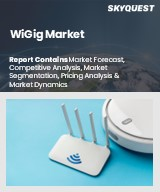
세계의 WiGig 시장 규모는 2023년에 193억 달러로 평가되며, 2024년 234억 5,000만 달러에서 2032년에는 1,113억 6,000만 달러로 성장하며, 예측 기간(2025-2032년)의 CAGR은 21.5%로 성장할 전망입니다.
세계의 WiGig 시장은 무선 기술의 발전, 원활한 연결성에 대한 수요, 데이터 집약적 용도의 부상 등에 힘입어 견고한 성장세를 보이고 있습니다. 고해상도 미디어 스트리밍, 가상현실, 클라우드 기반 서비스의 인기가 높아짐에 따라 초고속 멀티 기가비트 무선 솔루션에 대한 요구가 증가하고 있습니다. 기업은 빠른 파일 전송과 무선 도킹을 위해 WiGig 지원 디바이스를 빠르게 채택하여 네트워크 효율성을 크게 향상시키고 있습니다. 스마트폰, 노트북, 라우터에 WiGig 기술이 통합되면서 다양한 분야에서 폭넓게 채택되고 있습니다. 60GHz 주파수 대역의 혁신과 첨단 IEEE 표준 지원은 성장을 더욱 가속화하고 있습니다. 주요 기술 강화는 데이터 전송 속도와 안정성 향상에 중점을 두고 있으며, 칩 설계의 진보를 통해 가전제품의 저전력, 소형 WiGig 모듈을 실현하고 있습니다.
Global WiGig Market size was valued at USD 19.3 billion in 2023 and is poised to grow from USD 23.45 billion in 2024 to USD 111.36 billion by 2032, growing at a CAGR of 21.5% during the forecast period (2025-2032).
The global WiGig market is witnessing robust expansion, propelled by advancements in wireless technology, the demand for seamless connectivity, and the rise of data-intensive applications. The increasing popularity of high-resolution media streaming, virtual reality, and cloud-based services is amplifying the need for ultra-fast multi-gigabit wireless solutions. Businesses are swiftly adopting WiGig-enabled devices for high-speed file transfers and wireless docking, significantly enhancing network efficiency. The integration of WiGig technology in smartphones, laptops, and routers is fostering broad adoption across various sectors. Innovations in the 60 GHz frequency band and support for advanced IEEE standards are further accelerating growth. Key technological enhancements focus on increasing data transfer rates and stability, with advancements in chip designs enabling low-power, compact WiGig modules in consumer devices.
Top-down and bottom-up approaches were used to estimate and validate the size of the Global WiGig market and to estimate the size of various other dependent submarkets. The research methodology used to estimate the market size includes the following details: The key players in the market were identified through secondary research, and their market shares in the respective regions were determined through primary and secondary research. This entire procedure includes the study of the annual and financial reports of the top market players and extensive interviews for key insights from industry leaders such as CEOs, VPs, directors, and marketing executives. All percentage shares split, and breakdowns were determined using secondary sources and verified through Primary sources. All possible parameters that affect the markets covered in this research study have been accounted for, viewed in extensive detail, verified through primary research, and analyzed to get the final quantitative and qualitative data.
Global WiGig Market Segments Analysis
Global WiGig Market is segmented by Product, Type, End-User and region. Based on Product, the market is segmented into Display Devices and Network Infrastructure Devices. Based on Type, the market is segmented into 802.11ad and 802.11ay. Based on End-User, the market is segmented into Networking, Consumer Electronics, Commercial and Others. Based on region, the market is segmented into North America, Europe, Asia Pacific, Latin America and Middle East & Africa.
Driver of the Global WiGig Market
The expansion of the Global WiGig market is significantly influenced by the rising demand for ultra-high-speed data transfer in various consumer applications, including 4K and 8K video streaming, augmented reality (AR), virtual reality (VR), and wireless docking solutions. WiGig technology, capable of delivering data rates exceeding 7 Gbps with minimal latency, is increasingly seen as essential for both consumer and business environments that prioritize high-bandwidth performance. The growing consumption of digital content, especially in the realms of gaming and entertainment, further fuels the adoption of this advanced wireless technology, as users seek seamless and efficient connectivity for their high-end digital experiences.
Restraints in the Global WiGig Market
The Global WiGig market faces notable constraints due to its operation on the 60 GHz frequency band, which inherently restricts its effective range and reduces its ability to penetrate obstacles such as walls. This limitation confines its application primarily to short-range scenarios that require a direct line of sight, thereby hindering broader implementation in various environments. Consequently, for larger residential areas or high-density enterprise settings, the need for multiple access points emerges, complicating the deployment process. As a result, these challenges can deter widespread adoption and limit the technology's overall market potential.
Market Trends of the Global WiGig Market
The Global WiGig market is experiencing a significant trend driven by the widespread adoption of the 802.11ay standard, which addresses the increasing demand for higher data rates, expanded bandwidth, and enhanced range. With capabilities of delivering multi-gigabit speeds of up to 40 Gbps, along with advanced features like multi-user MIMO and improved beamforming, WiGig is becoming a crucial technology for applications in augmented and virtual reality, 8K video streaming, and sophisticated enterprise networks. This transition is effectively expanding the potential use cases for WiGig, moving beyond near-field communication to more scalable and innovative wireless solutions across various sectors.